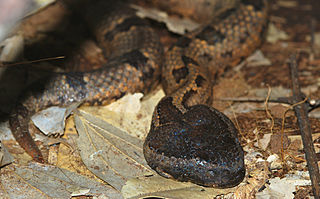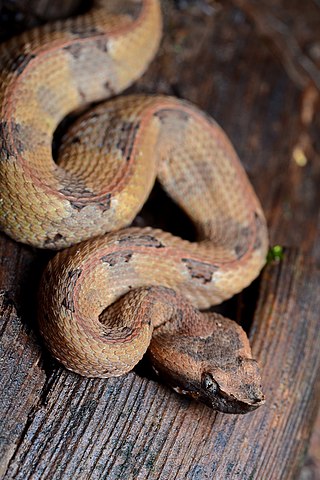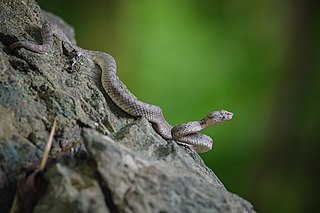
Trimeresurus is a genus of pit vipers found in Asia from the Indian Subcontinent throughout Southeast Asia, China, and the Pacific Islands. Currently 44 species are recognized. Common names include Asian palm pit vipers, Asian lanceheads, and green pit vipers.

Ovophis monticola, commonly known as the Chinese mountain pit viper, is a pit viper species found in Asia. Currently, two subspecies are recognized, including the nominate subspecies described here. Recent taxonomic work suggests that most of these should be considered as separate species. IUCN has already evaluated O. m. makazayazaya as Ovophis makazayazaya.

Protobothrops jerdonii, also known commonly as Jerdon's pit viper, the yellow-speckled pit viper, and the oriental pit viper, is a species of venomous snake in the subfamily Crotalinae of the family Viperidae. The species is native to India, Nepal, Myanmar, China, and Vietnam. Three subspecies are recognized, including the nominate subspecies described here.

Protobothrops mucrosquamatus is a pit viper species endemic to Asia. Common names include: brown-spotted pit viper, Taiwanese habu and pointed-scaled pit viper. No subspecies are currently recognized. The species was first described by Theodore Cantor in 1839.

Trimeresurus albolabris, the white-lipped pit viper or white-lipped tree viper, is a venomous pit viper species endemic to Southeast Asia.

Trimeresurus purpureomaculatus is a venomous pit viper species native to India, Bangladesh and Southeast Asia. Common names include: mangrove pit viper, mangrove viper, and shore pit viper.

Trimeresurus stejnegeri is a species of venomous pit viper endemic to Asia. Two subspecies are currently recognized, including the nominate subspecies described here.

Protobothrops mangshanensis, commonly known as the Mangshan pit viper, Mt. Mang pit viper, or Mang Mountain pit viper, is a pit viper species endemic to Hunan and Guangdong provinces in China. No subspecies are currently recognized. This is a nocturnal pit viper that is also known as the ''Mangshan iron-head snake'', ''Chinese pit viper'', and the ''Ironhead viper''. They eat frogs, birds, insects, and small mammals. They have a white tail tip that they wiggle to mimic a grub so that prey comes into striking range—a behaviour known as caudal luring. The venom causes blood clotting and corrodes muscle tissue and can be fatal to humans if not treated. Unusually for vipers, P. mangshanensis is oviparous with the female laying clutches of 13–21 eggs which she will guard until they hatch.

Ovophis is a genus of pit vipers found in Asia. Seven species are currently recognized.

Porthidium nasutum is a pit viper species found in southern Mexico, Central America and northern South America. No subspecies are currently recognized.
Protobothrops jerdonii bourreti, commonly known as Bourret's pitviper, is a subspecies of venomous pit viper in the family Viperidae. The subspecies is endemic to Vietnam.

Ovophis okinavensis, commonly known as the hime habu (ヒメハブ), Ryukyu Island pit viper, and the Okinawan pitviper, is a pit viper species found in the Ryukyu Islands of Japan. No subspecies are currently recognized.

Protobothrops elegans is a pit viper species endemic to Japan in the southern Ryukyu Islands. No subspecies are currently recognized. Common names include: elegant pit viper, Sakishima habu (サキシマハブ), and elegant tree viper.

Protobothrops flavoviridis is a species of pit viper endemic to the Ryukyu Islands of Japan. No subspecies are currently recognized. Local common names include habu, Okinawa habu, and Kume Shima habu.

The Tokara habu is a pit viper species endemic to the Tokara Islands of Japan. No subspecies are currently recognized.

Trimeresurus kanburiensis is a species of pit viper found in only a few areas of Thailand. Common names include: Kanburi pitviper, Kanburian pit viper, and tiger pit viper. Highly venomous, it is an arboreal but heavily built species with a brown or tawny coloration. No subspecies are currently recognized.

Protobothrops xiangchengensis, commonly known as the Szechwan pit viper, Kham Plateau pit viper, or Sichuan lancehead, is a pit viper species endemic to the Hengduan Mountains in south-central China. No subspecies are currently recognized.
Protobothrops kaulbacki, commonly known as Kaulback's lance-headed pit viper or Kaulback's lance-headed pit viper, is a pit viper species endemic to Asia. There are no subspecies that are recognized as being valid.

Trimeresurus macrops is a venomous pit viper species endemic to Southeast Asia. No subspecies are currently recognized. Common names include large-eyed pitviper, green pit viper, and Kramer's pit viper.

















